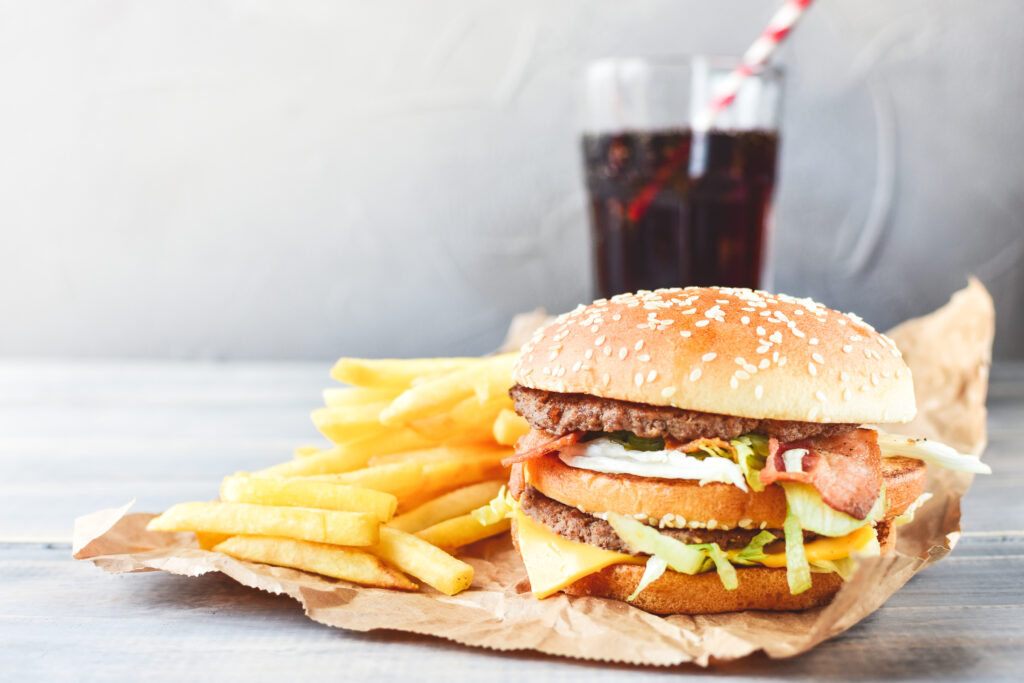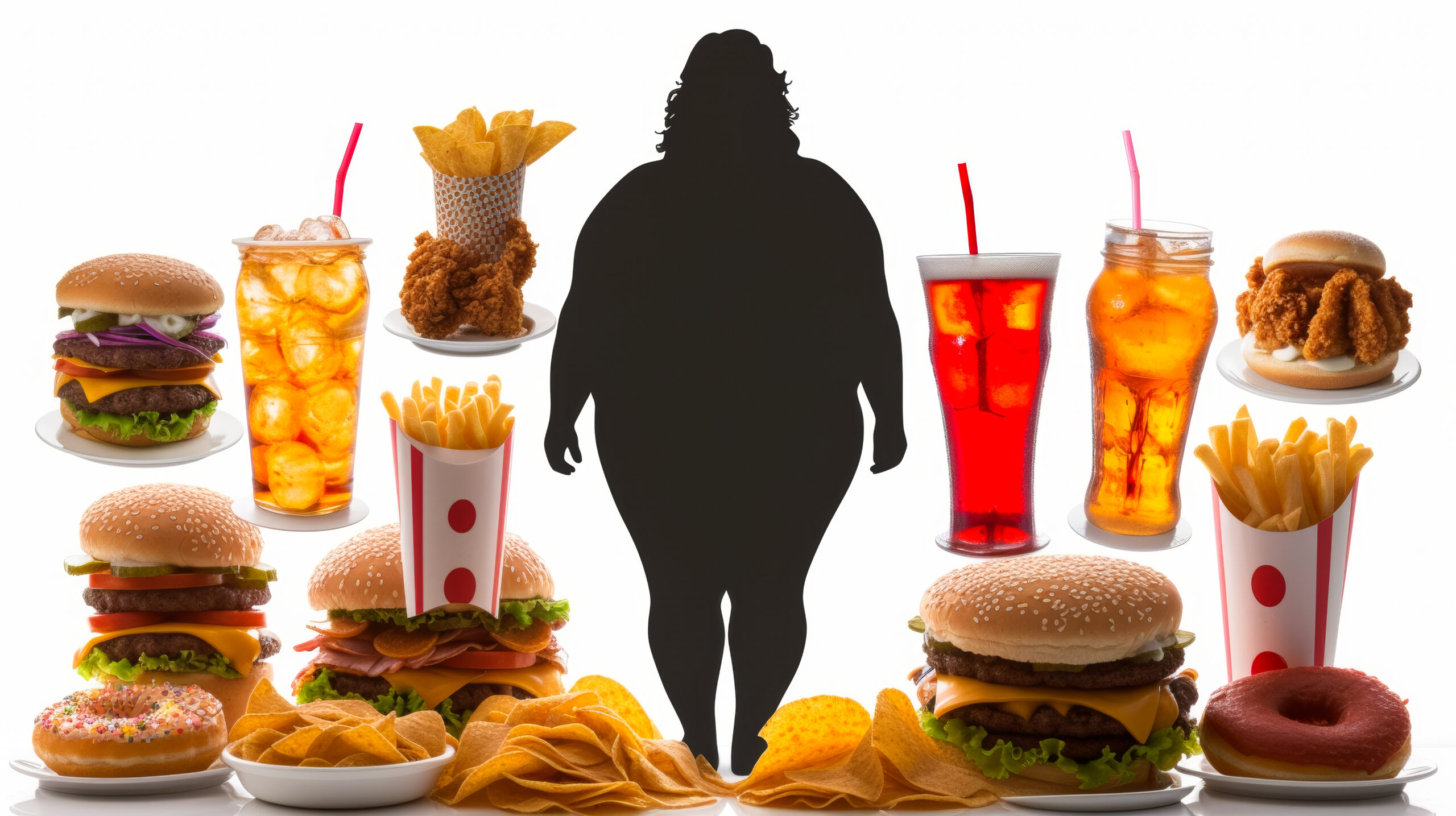Avoid These Foods To Lose Weight – Diet Soda, Vegetable Oils, And High Fat-High Carbohydrate Meals All Cause Fat Gain
It’s no secret that a healthy diet is an essential part of any weight loss journey. However, there’s a discrepancy over which foods are actually healthy and which are only touted as healthy through manipulative marketing. For example, you might be surprised to know that consuming “diet” drinks or foods actually lead to weight gain, not weight loss. I know, it’s crazy that something labeled as diet does the exact opposite, but that is the world we live in. At the end of the day, you must take it upon yourself to avoid certain foods to lose weight.
Avoid These Foods To Lose Weight – Diet Soda
Many people turn to diet soda when trying to lose weight because it seems like a guilt-free indulgence. However, artificially sweetened beverages lead to weight gain and other health problems.1
One reason for this is that artificial sweeteners disrupt the body’s natural ability to regulate calorie intake based on the sweetness of foods. This leads to overeating or consuming more unhealthy foods in an effort to satisfy cravings.2
Additionally, studies have linked regular consumption of diet soda with an increased risk of metabolic syndrome, which includes symptoms such as high blood pressure, high blood sugar, and excess body fat around the waist.3
Furthermore, diet soda has negative effects on gut health. Artificial sweeteners alter the balance of bacteria in the gut, which have drastic consequences on overall health.4
It is best to avoid products marketed as diet, as they do the exact opposite and are linked to health complications. Read food labels carefully or better yet, choose whole, organic, unprocessed foods exclusively.
High Fat And High Carb Meals – The Randle Cycle
The Randle Cycle explains how our bodies store and use energy from food. When we consume high-fat/high-carbohydrate meals, our body stores both the fat and carbohydrates as body fat. This cycle hinders weight loss efforts by promoting fat storage.
However, when we consume a low-fat/high-carbohydrate meal or a high-fat/low-carbohydrate meal, our body burns either energy source efficiently for immediate needs without storing much body fat. If you want to lose weight, stop eating fatty, carbohydrate rich meals.5

How Diet Variation Leads To Fat Burning
Diet variation is the practice of regularly changing your diet by including a variety of different foods. This includes varying proteins, carbohydrates, fats, and micronutrients consumed on a daily, weekly, or monthly basis. By doing so, our bodies are constantly challenged to adapt to different sources of fuel and nutrients.
While eating a high fat/high carbohydrate meal from time to time doesn’t have any drastic consequences, consuming it every single day at every meal leads to fat gain. Practicing diet variation by mixing up protein rich meals, high carbohydrate rich meals, and high fat meals over the course of the month keeps the body guessing as to what is coming next.
One key benefit of diet variation is increased fat burning. When we stick to the same diet for an extended period of time, our bodies become efficient at utilizing the nutrients and calories from that specific diet. As a result, weight loss often plateaus and our metabolism slows down. However, by constantly changing our diet, our bodies are forced to adapt to new types of foods, improving microbiome diversity and increasing fat loss.
Moreover, diet variation also helps with sustainable weight management. Unlike restrictive diets that often lead to yo-yo dieting and weight gain, incorporating variety into our eating habits allows for a more balanced approach to nutrition. This means we are less likely to feel deprived or restricted, reducing the chances of giving in to unhealthy cravings and binge eating.6
Avoid These Foods To Lose Weight – Vegetable Oils
Vegetable oils, also known as ‘seed oils’ are extracted from various plant seeds including soybean, corn, sunflower, rapeseed (canola), and cottonseed. While vegetable oils are commonly used for cooking and baking, they have disastrous effects on our health and weight loss goals.
Unlike other plant-based oils such as olive oil or avocado oil that offer health benefits due to their healthy fats, vegetable oils are high in unhealthy fats. These oils are highly refined and undergo a process called hydrogenation where they become partially or fully hydrogenated. This process changes the chemical structure of the oil, making it more stable and prolonging its shelf life. However, this also creates trans fats, which are known to increase the risk of heart disease, inflammation, and weight gain.7
Vegetable oils contain high levels of omega-6 fatty acids, which disrupt the delicate balance of omega-3 to omega-6 ratio in our bodies. This imbalance leads to chronic inflammation and obesity.8
Furthermore, an excess intake of omega-6 fatty acids from vegetable oils has been shown to interfere with hormone production and function. Hormones play a crucial role in regulating metabolism and appetite control, so any disruption in their balance makes weight loss challenging.9

Vegetable oil is highly susceptible to rancidity due to the high levels of polyunsaturated fatty acids (PUFA). Rancidity is a process where oils break down and produce an unpleasant odor and taste due to exposure to heat, light, oxygen, or moisture. Consuming this rancid oil leads to the formation of free radicals, which damage our cells and contribute to various diseases.10
Even worse, the rancid omega-6 fatty acids from vegetable oils integrate into the cellular membrane of our 70 trillion cells. This causes cellular membrane inflammation that is linked to cellular toxicity, an inability to produce cellular energy, and hormone resistance.11
How Cellular Membrane Inflammation Leads To Weight Gain
The cellular membrane is made up of a double layer of phospholipids that are embedded with proteins and cholesterol molecules. This structure allows for selective permeability, meaning it only allows specific substances to enter or exit the cell.
However, when the cellular membrane becomes inflamed, this selective permeability is compromised. The inflammation causes changes in the structure of phospholipids and proteins, altering their function and disrupting the normal flow of substances in and out of the cell.12
When the cellular membrane is inflamed, it leads to weight gain through several mechanisms, specifically insulin resistance, leptin resistance, thyroid hormone resistance, and increased fat storage.
Inflammation in the cellular membrane results in hormone resistance because hormone receptors become misshapen. When this happens, hormones aren’t able to bind to receptors efficiently and send their message into the cell. This is why so many people have hormone problems, not because they don’t have enough hormones, but because the cellular membranes are so inflamed that hormones aren’t able to dock at cellular receptors.13
Cellular membrane inflammation leads to insulin resistance, where cells become less responsive to insulin. This leads to an increase in blood sugar levels and triggers the body to store more fat.14
Leptin is a hormone that regulates appetite and metabolism. However, when there is inflammation in the cellular membrane, the body becomes less responsive to leptin, leading to increased appetite and decreased metabolism.15
Thyroid hormone resistance makes it difficult for thyroid hormones to bind to their receptors and carry out their functions. This results in a slower metabolism and weight gain.16
Inflammation in the cellular membrane also leads to increased storage of fat in adipose cells. This is due to changes in the function of proteins that transport fatty acids into the cell for storage.17
Read more about the link between vegetable oil and heart disease.
Losing Weight With The 5Rs
Cellular membrane inflammation hinders the body’s ability to lose weight but also triggers the activation of unfavorable genes. In addition to avoiding foods that lead to weight gain, it is essential to address inflammation head on. This is where the 5Rs come into play.
R1 – Remove The Source: The first step in the 5Rs method is to eliminate the factors that contribute to fat gain. This includes avoiding the foods we discussed and other unhealthy foods, as well as toxins that are linked to fat accumulation.
R2 – Regenerating The Cellular Membrane: Inflammation of the cellular membrane prevents essential nutrients from entering and waste products from leaving cells. It also impacts ATP synthesis, which hinders energy production and the body’s ability to detoxify properly. By regenerating the cellular membrane, we combat weight loss resistance at the core.
R3 – Restoring Cellular Energy: Once the cellular membrane is regenerated, it’s crucial to focus on restoring cellular ATP production and other vital pathways that have been depleted due to poor diet choices and toxins. This restores detox pathways within our cells, aiding in the removal of toxins.18

R4 – Reducing Cellular Membrane Inflammation: Even after detoxifying our cells, cellular membrane inflammation still persists. To address this issue, specific nutraceuticals are used to eliminate inflammation and restore normal cell function.19
R5 – Reestablishing Methylation: Methylation is an essential process that occurs in every cell of our body and plays a vital role in various functions. However, unhealthy foods and toxins disrupt this process and turn on bad genes that contribute to weight loss resistance. Nutraceuticals are required to restore proper methylation and promote overall health.20
Avoid These Foods To Lose Weight – Diet Soda, Vegetable Oils, And High Fat-High Carbohydrate Meals All Cause Fat Gain
It’s important to avoid diet soda, vegetable oils, and high-fat/high-carbohydrate meals to lose weight. Focus on incorporating whole, organic, unprocessed foods into your diet such as low-glycemic fruits, vegetables, grass-fed meat, grass-fed dairy, and healthy fats. Remember that diet variation is the key when it comes to maintaining a healthy weight.
Additionally, it is crucial to upregulate cellular function and cellular detoxification capacity as well as removing the sources that are contributing to fat accumulation. To restore proper metabolism, we must reduce cellular membrane inflammation that leads to hormone resistance as well as reestablish methylation to trigger the expression of genes that lead to fat loss.
Read more about diet variation or join me in my free Webinar to learn more about reversing weight loss resistance.
References
1 Yang Q. Gain weight by “going diet?” Artificial sweeteners and the neurobiology of sugar cravings: Neuroscience 2010. Yale J Biol Med. 2010 Jun;83(2):101-8. PMID: 20589192; PMCID: PMC2892765.
2 Pierce WD, Heth CD, Owczarczyk JC, Russell JC, Proctor SD. Overeating by young obesity-prone and lean rats caused by tastes associated with low energy foods. Obesity (Silver Spring). 2007 Aug;15(8):1969-79. doi: 10.1038/oby.2007.235. PMID: 17712114.
3 Nettleton JA, Lutsey PL, Wang Y, Lima JA, Michos ED, Jacobs DR Jr. Diet soda intake and risk of incident metabolic syndrome and type 2 diabetes in the Multi-Ethnic Study of Atherosclerosis (MESA). Diabetes Care. 2009 Apr;32(4):688-94. doi: 10.2337/dc08-1799. Epub 2009 Jan 16. PMID: 19151203; PMCID: PMC2660468.
4 Ruiz-Ojeda FJ, Plaza-Díaz J, Sáez-Lara MJ, Gil A. Effects of Sweeteners on the Gut Microbiota: A Review of Experimental Studies and Clinical Trials. Adv Nutr. 2019 Jan 1;10(suppl_1):S31-S48. doi: 10.1093/advances/nmy037. Erratum in: Adv Nutr. 2020 Mar 1;11(2):468. PMID: 30721958; PMCID: PMC6363527.
5 Hue L, Taegtmeyer H. The Randle cycle revisited: a new head for an old hat. Am J Physiol Endocrinol Metab. 2009 Sep;297(3):E578-91. doi: 10.1152/ajpendo.00093.2009. Epub 2009 Jun 16. PMID: 19531645; PMCID: PMC2739696.
6 Abdelhamid A, Jennings A, Hayhoe RPG, Awuzudike VE, Welch AA. High variability of food and nutrient intake exists across the Mediterranean Dietary Pattern-A systematic review. Food Sci Nutr. 2020 Jul 29;8(9):4907-4918. doi: 10.1002/fsn3.1784. PMID: 32994952; PMCID: PMC7500794.
7 DiNicolantonio JJ, O’Keefe JH Omega-6 vegetable oils as a driver of coronary heart disease: the oxidized linoleic acid hypothesis Open Heart 2018;5:e000898. doi: 10.1136/openhrt-2018-000898
8 Djuricic I, Calder PC. Beneficial Outcomes of Omega-6 and Omega-3 Polyunsaturated Fatty Acids on Human Health: An Update for 2021. Nutrients. 2021 Jul 15;13(7):2421. doi: 10.3390/nu13072421. PMID: 34371930; PMCID: PMC8308533.
9 DiNicolantonio JJ, O’Keefe J. The Importance of Maintaining a Low Omega-6/Omega-3 Ratio for Reducing the Risk of Autoimmune Diseases, Asthma, and Allergies. Mo Med. 2021 Sep-Oct;118(5):453-459. PMID: 34658440; PMCID: PMC8504498.
10 Esmaillzadeh A, Azadbakht L. Home use of vegetable oils, markers of systemic inflammation, and endothelial dysfunction among women. Am J Clin Nutr. 2008 Oct;88(4):913-21. doi: 10.1093/ajcn/88.4.913. PMID: 18842776.
11 Gu C, Philipsen MH, Ewing AG. Omega-3 and -6 Fatty Acids Alter the Membrane Lipid Composition and Vesicle Size to Regulate Exocytosis and Storage of Catecholamines. ACS Chem Neurosci. 2024 Feb 21;15(4):816-826. doi: 10.1021/acschemneuro.3c00741. Epub 2024 Feb 12. PMID: 38344810; PMCID: PMC10884999.
12 Ammendolia, D.A., Bement, W.M. & Brumell, J.H. Plasma membrane integrity: implications for health and disease. BMC Biol 19, 71 (2021). https://doi.org/10.1186/s12915-021-00972-y
13 Straub RH. Interaction of the endocrine system with inflammation: a function of energy and volume regulation. Arthritis Res Ther. 2014 Feb 13;16(1):203. doi: 10.1186/ar4484. PMID: 24524669; PMCID: PMC3978663.
14 Freeman AM, Acevedo LA, Pennings N. Insulin Resistance. [Updated 2023 Aug 17]. In: StatPearls [Internet]. Treasure Island (FL): StatPearls Publishing; 2024 Jan-. Available from: https://www.ncbi.nlm.nih.gov/books/NBK507839/
15 Gruzdeva O, Borodkina D, Uchasova E, Dyleva Y, Barbarash O. Leptin resistance: underlying mechanisms and diagnosis. Diabetes Metab Syndr Obes. 2019 Jan 25;12:191-198. doi: 10.2147/DMSO.S182406. PMID: 30774404; PMCID: PMC6354688.
16 Rivas AM, Lado-Abeal J. Thyroid hormone resistance and its management. Proc (Bayl Univ Med Cent). 2016 Apr;29(2):209-11. doi: 10.1080/08998280.2016.11929421. PMID: 27034574; PMCID: PMC4790576.
17 Ellulu MS, Patimah I, Khaza’ai H, Rahmat A, Abed Y. Obesity and inflammation: the linking mechanism and the complications. Arch Med Sci. 2017 Jun;13(4):851-863. doi: 10.5114/aoms.2016.58928. Epub 2016 Mar 31. PMID: 28721154; PMCID: PMC5507106.
18 Zolkipli-Cunningham Z, Falk MJ. Clinical effects of chemical exposures on mitochondrial function. Toxicology. 2017 Nov 1;391:90-99. doi: 10.1016/j.tox.2017.07.009. Epub 2017 Jul 27. PMID: 28757096; PMCID: PMC6078194.
19 Pall M. L. (2013). The NO/ONOO-cycle as the central cause of heart failure. International journal of molecular sciences, 14(11), 22274–22330. https://doi.org/10.3390/ijms141122274
20 Dhar GA, Saha S, Mitra P, Nag Chaudhuri R. DNA methylation and regulation of gene expression: Guardian of our health. Nucleus (Calcutta). 2021;64(3):259-270. doi: 10.1007/s13237-021-00367-y. Epub 2021 Aug 16. PMID: 34421129; PMCID: PMC8366481.
Disclaimer: All rights reserved. Information provided is for general purposes and not intended to provide medical advice, diagnosis, or treatment. Consult your healthcare professional for medical concerns. About Dr. Pompa




